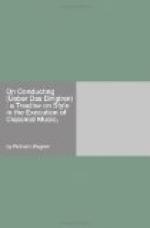first tempo of the opera (which is also an alla-breve
but a slower one)—and the pace must be
slackened accordingly. But our conductors, in
their customary crude way, generally miss this point
in the overture. We need not, however, now be
lead into premature reflections. Let us merely
consider it established that the character of the older
classical or, as I call it, naive Allegro differs greatly
from the new emotional sentimental Allegro, peculiar
to Beethoven. Mozart became acquainted with the
orchestral crescendo and diminuendo at Mannheim, (in
1777) when the orchestra there had acquired it as
a novelty: up to that time the instrumentation
of the old masters shows that, as a rule, nothing
was inserted between the forte and piano sections
of the allegro movements which can have been intended
to be played with emotional expression. Now,
how does the true Beethovenian Allegro appear with
regard to this? To take the boldest and most inspired
example of Beethoven’s unheard-of innovation
in this direction, the first movement of his Sinfonia
eroica: how does this movement appear if played
in the strict tempo of one of the Allegros of Mozart’s
overtures? But do our conductors ever dream of
taking it otherwise? Do they not always proceed
monotonously from the first bar to the last?
With the members of the “elegant” tribe
of Capellmeisters the “conception” of
the tempo consists of an application of the Mendelssohnian
maxim “chi va presto va sano.”
Let the players who happen to have any regard for
proper execution make the best of it in passages like:—
[Musical Score]
or the plaintive:—
[Musical Score]
the conductors do not trouble their minds about such
details; they are on “classic ground,”
and will not stop for trifles; they prefer to progress
rapidly “grande vitesse,” “time is
money.”
We have now reached the point in our discussion from
which we can judge the music of the day. It will
have been noticed that I have approached this point
with some circumspection. I was anxious to expose
the dilemma, and to make everyone see and feel that
since Beethoven there has been a very considerable
change in the treatment and the execution of instrumental
music. Things which formerly existed in separate
and opposite forms, each complete in itself, are now
placed in juxtaposition, and further developed, one
from the other, so as to form a whole. It is essential
that the style of execution shall agree with the matter
set forth— that the tempo shall be imbued
with life as delicate as the life of the thematic
tissue. We may consider it established that in
classical music written in the later style modification
of Tempo is a sine qua non. No doubt very great
difficulties will have to be overcome. Summing
up my experiences I do not hesitate to assert that,
as far as public performances go, Beethoven is still
a pure chimera with us. [Footnote: i.e..
in 1869.]




